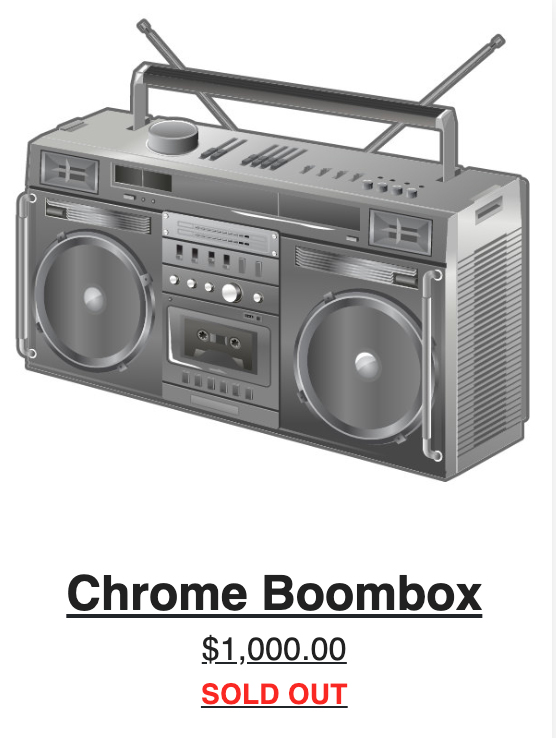在区块链的帮助下,数字艺术迎来突破时刻
莱尔·奥威尔科是一位著名摄影师,知名作品包括一张标志性的“9·11”照片和一个名为“立体声录放机项目”(Boombox Project)的系列,该系列的主顾包括麦当娜、Jay-Z等。3月中旬的一天,全美大部分地区都因为新冠病毒处于封锁状态,奥威尔科的一个新展览开幕了,不过是在网上。
这次展览是立体声录放机项目的延伸,展出了几十种不同颜色独一无二的数码图片,单价在20美元到2500美元之间。让奥威尔科惊喜的是,大部分展品都卖光了,包括下面这张:

这次展览在Nifty Gateway上举行,越来越多像Nifty Gateway一样的网站使用区块链技术为收藏者提供独一无二的艺术藏品。区块链的使用保证了交易记录无法被篡改破坏,也就是说,一幅数字图像可以被认定为独一无二的正版藏品——哪怕屏幕截图很容易就能进行复制,就像上图一样。
“确保数字艺术品的稀缺性在以前是不可能实现的。数字艺术运动已经开始了几十年,但直到最近,才能把数字艺术品包起来当成资产。”泰勒·文克莱沃斯说,他和他的孪生兄弟卡梅伦是Nifty Gateway的共同所有者,这家公司成立于2018年。
文克莱沃斯兄弟是比特币亿万富翁,因为和马克·扎克伯格就Facebook的创立打官司而声名鹊起。对他们来说,区块链技术有望打造一个全新的大型艺术品和收藏品市场。他们希望收藏者能够看到,数字艺术品可以像原版印刷品或画像一样独一无二——即使被大量复制放在礼品店里售卖,也还是能卖出大价钱。
Nifty Gateway由另一对双胞胎邓肯和格里芬·考克·福斯特经营,该公司表示,截至目前已经卖出了数千件数字收藏品,不过没有透露具体数量,也没有透露网站的总营收。
对于立体声录放机系列的作者奥威尔科来说,区块链还有助于打击明目张胆的伪造和非法复制,长期以来,这些行为让互联网时代的艺术家们倍感沮丧。他将区块链的追踪系统比作车辆识别码(VIN),提供了一种登记和识别购入和售出的每一辆汽车的方法。
根据文克莱沃斯兄弟的说法,当艺术家的作品被转售时,像Nifty Gateway这样的数字艺术门户为艺术家提供了一种收取版税的新方式,一种和实体艺术品行业不同的方式。他们还声称,在原始销售中他们收取的佣金比例远低于实体画廊通常收取的50%。
该公司拒绝透露从销售中收取的具体佣金,也不愿透露艺术家转售作品时能得到的版税。
数字艺术品通常包括网上出售的照片和插图,尽管它们在新冠肺炎大流行期间可能得到了新的关注,但相较于更广泛的艺术市场而言,仍然只占很小的一部分,而且对于许多艺术爱好者来说并不熟悉。
传统画廊行业在疫情期间遭受重创。《洛杉矶时报》(Los Angeles Times)的一项调查显示,当地的一批画廊或将关闭,几十家画廊已经申请了薪酬保障计划(Paycheck Protection Program)。一些店主还在思考今后的展览如何开展,因为只能允许少数人进入以维持社交距离,还有一些店主则提供了“在线参观室”(也就是网站),让艺术爱好者可以在线观赏以及购买作品。不过,在《洛杉矶时报》这篇详尽的调查报告中,并没有提及纯数字艺术的销售。
澳大利亚插画家凯蒂·阿灵顿对这个市场的增长仍然持乐观态度。她一直在另一家区块链艺术品门户网站MakersPlace上展示她独特的数字作品,该网站由在线图钉板网站Pinterest的前雇员创建。
“它把我和一个真正热爱数字艺术的社区联系了起来,特别棒。”阿灵顿说,她补充道,使用区块链软件来展示她的插图一开始很难,但后来就更简便了。
Nifty Gateway选择完全隐藏区块链软件,这意味着希望购买数字艺术品的客户什么都不用干,只需要输入信用卡卡号。(想要在后台查看区块链注册表的买家也可以查看。)
然而,尽管区块链技术可能有利于数字艺术开辟新市场,但这类艺术能否跳出小众群体吸引更多收藏者,仍然是个问题。毕竟,对许多人来说,拥有艺术品的吸引力在于展示艺术品所带来的愉悦和地位——如果艺术品被锁在屏幕里,如何展示是个难题。
但奥威尔科乐观地认为,会有越来越多的人接受数字艺术,部分原因是新的显示器和数字纸将有助于更好地展示数字艺术品。
奥威尔科说:“过去三十年,我们已经经历了这么多富有创造性的环境,这将是下一次演化。”(财富中文网)
译者:Agatha
莱尔·奥威尔科是一位著名摄影师,知名作品包括一张标志性的“9·11”照片和一个名为“立体声录放机项目”(Boombox Project)的系列,该系列的主顾包括麦当娜、Jay-Z等。3月中旬的一天,全美大部分地区都因为新冠病毒处于封锁状态,奥威尔科的一个新展览开幕了,不过是在网上。
这次展览是立体声录放机项目的延伸,展出了几十种不同颜色独一无二的数码图片,单价在20美元到2500美元之间。让奥威尔科惊喜的是,大部分展品都卖光了,包括下面这张:
这次展览在Nifty Gateway上举行,越来越多像Nifty Gateway一样的网站使用区块链技术为收藏者提供独一无二的艺术藏品。区块链的使用保证了交易记录无法被篡改破坏,也就是说,一幅数字图像可以被认定为独一无二的正版藏品——哪怕屏幕截图很容易就能进行复制,就像上图一样。
“确保数字艺术品的稀缺性在以前是不可能实现的。数字艺术运动已经开始了几十年,但直到最近,才能把数字艺术品包起来当成资产。”泰勒·文克莱沃斯说,他和他的孪生兄弟卡梅伦是Nifty Gateway的共同所有者,这家公司成立于2018年。
文克莱沃斯兄弟是比特币亿万富翁,因为和马克·扎克伯格就Facebook的创立打官司而声名鹊起。对他们来说,区块链技术有望打造一个全新的大型艺术品和收藏品市场。他们希望收藏者能够看到,数字艺术品可以像原版印刷品或画像一样独一无二——即使被大量复制放在礼品店里售卖,也还是能卖出大价钱。
Nifty Gateway由另一对双胞胎邓肯和格里芬·考克·福斯特经营,该公司表示,截至目前已经卖出了数千件数字收藏品,不过没有透露具体数量,也没有透露网站的总营收。
对于立体声录放机系列的作者奥威尔科来说,区块链还有助于打击明目张胆的伪造和非法复制,长期以来,这些行为让互联网时代的艺术家们倍感沮丧。他将区块链的追踪系统比作车辆识别码(VIN),提供了一种登记和识别购入和售出的每一辆汽车的方法。
根据文克莱沃斯兄弟的说法,当艺术家的作品被转售时,像Nifty Gateway这样的数字艺术门户为艺术家提供了一种收取版税的新方式,一种和实体艺术品行业不同的方式。他们还声称,在原始销售中他们收取的佣金比例远低于实体画廊通常收取的50%。
该公司拒绝透露从销售中收取的具体佣金,也不愿透露艺术家转售作品时能得到的版税。
数字艺术品通常包括网上出售的照片和插图,尽管它们在新冠肺炎大流行期间可能得到了新的关注,但相较于更广泛的艺术市场而言,仍然只占很小的一部分,而且对于许多艺术爱好者来说并不熟悉。
传统画廊行业在疫情期间遭受重创。《洛杉矶时报》(Los Angeles Times)的一项调查显示,当地的一批画廊或将关闭,几十家画廊已经申请了薪酬保障计划(Paycheck Protection Program)。一些店主还在思考今后的展览如何开展,因为只能允许少数人进入以维持社交距离,还有一些店主则提供了“在线参观室”(也就是网站),让艺术爱好者可以在线观赏以及购买作品。不过,在《洛杉矶时报》这篇详尽的调查报告中,并没有提及纯数字艺术的销售。
澳大利亚插画家凯蒂·阿灵顿对这个市场的增长仍然持乐观态度。她一直在另一家区块链艺术品门户网站MakersPlace上展示她独特的数字作品,该网站由在线图钉板网站Pinterest的前雇员创建。
“它把我和一个真正热爱数字艺术的社区联系了起来,特别棒。”阿灵顿说,她补充道,使用区块链软件来展示她的插图一开始很难,但后来就更简便了。
Nifty Gateway选择完全隐藏区块链软件,这意味着希望购买数字艺术品的客户什么都不用干,只需要输入信用卡卡号。(想要在后台查看区块链注册表的买家也可以查看。)
然而,尽管区块链技术可能有利于数字艺术开辟新市场,但这类艺术能否跳出小众群体吸引更多收藏者,仍然是个问题。毕竟,对许多人来说,拥有艺术品的吸引力在于展示艺术品所带来的愉悦和地位——如果艺术品被锁在屏幕里,如何展示是个难题。
但奥威尔科乐观地认为,会有越来越多的人接受数字艺术,部分原因是新的显示器和数字纸将有助于更好地展示数字艺术品。
奥威尔科说:“过去三十年,我们已经经历了这么多富有创造性的环境,这将是下一次演化。”(财富中文网)
译者:Agatha
Lyle Owerko is a celebrated photographer known for an iconic 9/11 photo, and for an art series called the Boombox Project, whose patrons include Madonna and Jay-Z. In mid-March, on a day much of the country went into lockdown because of the coronavirus, Owerko opened a new exhibition—online.
The exhibition was an extension of the Boombox Project, featuring several dozen unique digital prints in a variety of colors, costing $20 to $2,500. To Owerko's pleasant surprise, most of them sold out, including the one pictured below:
The exhibition took place on Nifty Gateway, one of a growing number of websites that use blockchain technology to offer collectors a unique work of art. The use of blockchain, which creates a tamperproof and indestructible transaction record, means that a given digital image can be designated as distinct and authentic—even if a version of it can be easily reproduced in screenshots like the one above.
"Enforcing scarcity in digital art couldn’t happen before. The digital art movement has existed for decades, but until recently you couldn’t box it up and create an asset out of it," says Tyler Winklevoss, who, along with his twin brother, Cameron, owns Nifty Gateway, which was founded in 2018.
For the Winklevoss twins, Bitcoin billionaires who gained fame for their legal battle with Mark Zuckerberg over Facebook's founding, blockchain technology promises to create a major new art and collectibles market. They hope that collectors will come to see that digital art can be unique in the same way as original prints or portraits—which can fetch enormous sums even if they are widely reproduced as gift shop collectibles.
Nifty Gateway, which is operated by a second pair of twins, Duncan and Griffin Cock Foster, says it has so far sold thousands of digital collectibles, though it has not disclosed a specific number nor the site's overall revenue.
For Owerko, the Boombox artist, blockchain also promises a way to combat the blatant counterfeiting and illicit reproduction that has long frustrated artists in the Internet age. He likens blockchain's tracing system to a vehicle identification number (VIN), which provides a way to register and identify every car bought and sold.
And according to the Winklevoss twins, digital art portals like Nifty Gateway provide a way for artists—unlike in the world of physical art—to collect royalties when one of their works is resold. They also claim that in the case of original sales, the percentage they take as a commission is much lower than the 50% physical galleries typically collect.
The company declined to disclose the specific commission it collects on sales or the royalties that artists can earn for those resales.
But while digital art, which typically consists of photos and illustrations sold on websites, may be receiving new attention during the pandemic, it's still a tiny fraction of the broader art market, and one that's unfamiliar to many art lovers.
The traditional gallery world has taken a battering during the pandemic. A survey by the Los Angeles Times suggested that a number of galleries in that city expect to close, and that dozens had applied for the Paycheck Protection Program. Some owners are also mulling future exhibits that admit only a handful of people to respect social distancing, while others are offering "online viewing rooms" (a.k.a. websites) where art fans can view and purchase works. The idea of selling purely digital art did not come up, however, in the Times' detailed overview.
Katy Arrington, an Australia-based illustrator, is nonetheless optimistic the market will grow. She has been exhibiting unique digital works on MakersPlace, another blockchain art portal, created by former employees of online pin board Pinterest.
"It connected me to a community that really valued digital art; it was pretty awesome," says Arrington, who added that using the blockchain software required to exhibit her illustrations proved difficult at first, but has since become more intuitive.
In the case of Nifty Gateway, the company opted to conceal the blockchain software altogether, meaning customers wishing to buy digital art don't have to do anything more than enter a credit card number. (Buyers who want to look under the hood at the blockchain registry are still able to do so.)
But while the technology may have arrived to facilitate a new market in digital art, it's an open question whether such art will appeal to more than a small niche of collectors. After all, the appeal of owning art for many people is the pleasure and status that can come with displaying it—a difficult proposition if the art is locked in a screen.
Owerko, however, is optimistic that a growing number of people will embrace digital art, in part because of new monitors and digital paper that will enhance the ability to display it.
Says Owerko, "We’ve moved through so many creative environments in the last three decades, that this is the next evolutionary step."













